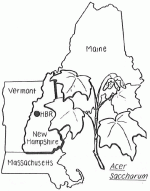The USDA Forest Service established the Hubbard Brook Experimental Forest (HBR) as a research laboratory in 1955. Hubbard Brook is currently managed by the Forest Service, Northeastern Forest Experiment Station, Durham, New Hampshire, and is used to study watershed management problems by scientists from the Forest Service and cooperating institutions such as Cornell University, Dartmouth College, the Institute of Ecosystem Studies from the New York Botanical Garden, Syracuse University and Yale University.
The Hubbard Brook Ecosystem Study (HBES) was initiated in 1963 in an effort to improve the understanding of the structure and dynamics of northern hardwood forests and their interconnected aquatic systems. An important resource resulting from this research is a long-term record of physical, chemical and biological parameters. The Hubbard Brook LTER is building upon this ongoing program and the extensive base of research results. Besides contributing to the continued monitoring of climate, hydrology, biogeochemistry, and plant and heterotroph populations in the HBR catchments, LTER researchers axe utilizing field manipulations and simulation modeling to help reveal internal mechanisms regulating the large-scale behavior of the watershed study unit.
Precipitation Record
The long-term record of precipitation chemistry from HBR has been an extremely valuable source of information on acid rain. Recently, coupled declines in the deposition of sulfate and H have been documented at the site. Driscoll et al (1989) have examined long-term trends in streamwater chemistry in response to changes in atmospheric deposition. Stream sulfate in watershed 6 (W6) shows declines which are consistent with decreasing precipitation inputs of sulfate. However, this decline has not resulted in any change in stream acidity. Rather, decreases in sulfate have been offset by near stoichiomethc decreases in basic cations. The decline in stream concentrations of basic cations may be due to reduced leaching from soil cation exchange sites and/or decreases in atmospheric deposition of basic cations. The contribution of atmospheric inputs of basic cations in regulating the acid-base status of soil and drainage water was unexpected and could have important policy implications for air pollution control.
Continued analysis of acid-base balances is a central focus of our LTER project; for example, we are attempting to refine estimates of dry deposition by comparing three methods: water shed mass balances, aerodynamic approaches, and throughfall regression estimates. Repeated remeasurements of the vegetation of W6 indicate that the biomass of the approximately 75 year-old forest has unexpectedly stabilized during the most recent five-year interval (1982-1987). This result does not match predictions of a forest growth simulator developed in part at HBR.
Large-Scale Disturbance
A recurring theme at HBR has been large-scale disturbance and the biotic regulation of ecosystem element cycles. Most recently, ecosystem recovery was characterized following a whole-tree clearcut of Watershed 5, in an effort to quantify the mechanisms influencing the watershed-level behavior observed in previous disturbance experiments.
Currently, these studies are being integrated in a synthesis volume.
Among the new observations and C.) insights this research has contributed are:
- The strong longitudinal trends in acidity and trace metal concentrations along the course of streams, resulting from spatial variation in soils and source-areas for streamflow
- The rapid but brief transition of the stream from a detritus to an algal food base
- The large potential contribution of decaying fine roots to the loss of some nutrient elements during the first two years after forest harvest
- The high spatial variation in nutrient accumulation by vegetation and, conversely, in nutrient leaching from upper soil horizons
- The large amounts of mixing and burial of forest floor horizons during logging operation and the fate of this buried organic matter
- The contribution of “hot-spots” of gaseous emissions to nitrogen losses from the disturbed watershed. Synthesis volume seeks to integrate this information in both scientific and management contexts
Long-Term Monitoring
Long-term monitoring efforts at HER have not been limited to biogeochemical measurements, but include detailed observations of nesting birds and their food sources. LTER funding has allowed us to improve the sampling program for insect populations and thereby help understand the factors regulating changes in bird population sizes. Following a steady, long-term decline in population sizes in the Hubbard Brook region, the total number of breeding birds appears to have stabilized in the last few years.
Other Research Areas
Other active areas of research include:
- A detailed study and modeling of hydrologic flow paths within forested watersheds
- Nutritional dynamics of small mammals and deer on the recovering clearcut watersheds
- Interactions of the ubiquitous fungal groups, Armillaria and Trichoderma.
Long-term changes in the forest floor and mineral soil horizons following large-scale disturbance, and documentation of changes in vegetation composition, biomass and chemistry in permanent watershed plots with contrasting disturbance histories.
HBR is also developing research linkages with other LTER sites including: studies of bole wood decay (H.J. Andrews and Coweeta); vegetation and soil response to large-scale disturbance (Luquillo and other forested sites); hydrogeochemical processes in first-order stream catchments (Niwot Ridge); and near-stream biogeochemical processes (Arctic Tundra).
For additional information contact Charles Driscoll, Department of Civil Engineering, Syracuse University, Syracuse, NY 13244-1190, or Timothy Fahey, Department of Natural Resources, Cornell University, Ithaca, NY 14853.

 Enlarge this image
Enlarge this image